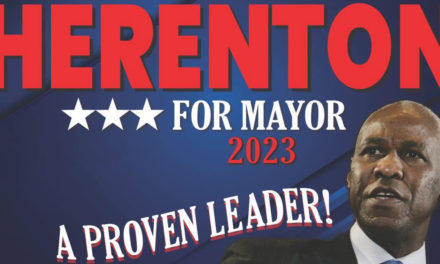Thumbnail: Another volatile county commissioners’ meeting resulted from suggestions that the sheriff’s budget should be reduced. The budget is significantly larger than the mayor’s budget and accounts for 45% of the general fund. The sheriff needs to step forward to lead the process to reimagine better law enforcement.
**
After the rancorous smoke had cleared this week, the Shelby County Board of Commissioners had voted down two resolutions to reduce the budget of the Shelby County Sheriff – one to reduce the budget by $17.9 million and a second to reduce it by 5%, or $8.9 million.
The proposals by Commissioner Tami Sawyer even provoked Chairman Mark Billingsley to clumsily claim any cuts to Sheriff Floyd Bonner’s budget were signs of “disrespect” to the African American sheriff. He also tried to correct Ms. Sawyet for using the “f-word” in telling a story about a deputy who had cursed her.
Ms. Sawyer is an African American Democrat and Mr. Billingsley, a white Republican, represents Germantown, Southwind, Windyke, and South Cordova.
Ms. Sawyer then accused Mr. Billingsley of lecturing her on racism and was still mad enough to deliver a blistering retort later on Facebook: “The next time you want to spout some black facts you read off your phone, I will remind you that I live it every day.”
Meanwhile, the commission chairman was catastrophizing any cuts to sheriff’s budget. He was reflexively supported by the CAO of the sheriff’s department Steve Leech, who treated the proposed budget cut like it tantamount to the fall of Rome.
Special Handling
All in all, it continued what has been an ugly year of charges, countercharges, personal attacks, and poor behavior that is eroding public support for a body that used to be the most highly regarded in Shelby County.
But, now, that seems long ago.
The lack of camaraderie, much less comity, appears to have swamped the body and prevents serious and thoughtful discussion about reducing the sheriff’s budget, which has been climbing steadily for as long as most people in the Vasco Smith Administration Building can remember and now is about $62 million larger than the budget of the mayor.
It is a strange anomaly of Shelby County Government that in the midst of tough budget times, the Sheriff’s Department’s budget has always been treated as sacrosanct. Maybe it began during the time when the legislative body didn’t even approve the budget. Rather, the sheriff took his spending request to a friendly Criminal Court Judge who reliably rubber stamped every year.
It’s been said that because the first three mayors of Shelby County served as sheriffs (Jim Rout was in the office for only two months when he was coroner and by law, the coroner filled in temporarily when a sheriff stepped down). Then too, after AC Wharton was elected as county mayor, Mark Luttrell, also a former sheriff, was then elected as the county executive.
The Ever Growing Sheriff’s Budget
Fortunately, those days when judges controlled the sheriff’s budget are past but even today, while commissioners have all kinds of advice for the county mayor about his divisions, the sheriff regularly gets what he wants. This year, the proposed budget for the sheriff calls for $183 million in expenditures, a $3 million increase.
Looking for budget cuts is like the robber who was asked why he robbed banks and he replied: because that’s where the money is. The sheriff’s budget is where the money is.
Its $183 million in expenses is considerably larger than the mayor’s $121 million budget although more of the arrows seem to be fired in the mayor’s direction.
In the 2011 fiscal year, the sheriff’s budget was just over $160 million and has climbed by $23 million since then. Today, the sheriff’s expenditures amount to 45.4% of the general fund, compared to about 39% in 2015. As for the mayor’s divisions, their expenses amount to 29.3% of the general fund.
The sheriff’s budget is long overdue for the kind of detailed review that it deserves. It’s even more pressing in today’s climate in which the public is demanding for government to invest in programs that open up more opportunity and equity for African Americans and to transfer the money for this priority to come from law enforcement’s bloated budgets. In Memphis, the proposed budget gives MPD $9.3 million more as its $282.1 million budget amounts to 40% of the general fund.
Time To Quit Talking And Act
As we wrote last week, if there’s any place in the country where this heightened emphasis on equity and equality, it is this one, where the population of Memphis is 62% African American, the population of Shelby County is 54%, and the population of the MSA will be 65% people of color and 47% African American by 2030.
This community has a tradition of drifting toward the future as if we have no ability to shape it; we are merely victims of forces we can’t control. It is a malignancy whose cure requires government and business to do more than talk, but to act. Otherwise, we will validate the prevalent narrative of African Americans that we are just likely to talk big, do little, wait for the crisis to pass and return to business as usual.
And yet, this time, it is different. There is a new reality. A new generation of activists have joined with older warriors to demand change and they won’t be deterred. Continuing to treat the sheriff’s budget as if it is untouchable and comments by the city mayor that he isn’t interested in defunding police will invoke Newton’s third law: For every action, there is an equal and opposite reaction.
We know it appeals to the base of some white politicians to say, “I’m against defunding police,” it is a cynical position to take, because they know that the mantra does not mean abolishing the police. It merely means that it’s time to take a new and different look at how law enforcement can better serve the public. That seems reasonable since Memphis police have fatally shot more than two dozen African Americans in recent years. Such a process of reinvention should include members of the public because the Memphis Shelby Crime Commission for too long has had an oversized influence on decisions about law enforcement and criminal justice.
Perhaps, just perhaps, if we began with a blank sheet of paper, we could design a system that works better, fairer, and with more equality toward the people it is sworn to protect. Why some politicians would reject this out of hand is baffling.
Why Not Treat Police Like Other Departments?
The current structures of MPD and the Sheriff’s Department were not handed down by Moses from Mount Sinai. City government in particular has prided itself on taking new looks at its services to save money, to make them more efficient, and to improve their performance. There’s no reason law enforcement should not have the same introspection.
Over the years, there have been multiple studies and recommendations of the police department, like those by the Police Research Forum Report (PERF), whose full report, to our knowledge, was never released to the public. That said, it dealt more with issues like dog calls, false alarms, and burglar alarms rather than address the genuine reform of police services that is needed.
As Mark Luttrell, who was a corrections official and sheriff before he was elected county mayor, said often: reducing crime is a three-legged stool – suppression (arrests), prevention, and intervention. He said that arresting people was the easy part. Prevention and intervention are harder.
Maybe that’s why more and more money is thrown at suppression while prevention and intervention languish for lack of attention and resources directed at them. Other cities have proven that any correlation between the size of the police force and the crime rate is tenuous. They have reduced the number of police and the crime rate went down, because of their emphasis on intervention and prevention.
Looking For The Sheriff To Lead Us
As an official elected countywide as chief law enforcement officer, there’s no reason that Sheriff Floyd Bonner, with 40 years of experience, should not be looked to for more than business as usual. He could be charged to design, develop, and activate a program to reduce crime through intervention and prevention strategies.
If the sheriff is intent on making sure his budget is untouched, it would be a step forward if he would redirect some of his resources to test some experimental programs in community policing, neighborhood relationship-building, and adding non-law enforcement specialists to help in situations that require mental health experts and people skilled in specialized deescalation strategies.
In other words, it’s time for the county sheriff to see his role as more than managing a jail, providing officers for more than 40 courts, serving arrest warrants, and patrolling the unincorporated area of Shelby County.
More to the point, as the constitutional law officer in Shelby County, we should be able to look to him for innovations, as an outspoken voice for equal rights and equal treatment, and with the moral authority as the father of two black sons and three grandchildren to understand the issues from both sides.
***
Note: There’s a joke in Shelby County Government that the budget document is changed regularly to make it difficult for people to read it. As one longtime official said: “Every time we figure it out, they change it so we have to rely on them to tell us what’s in it.” The budget numbers in this post were developed with the most care in getting them right from a document that often defies understanding.
***
Click here to join us at the Smart City Memphis Facebook page for daily articles, reports, and commentaries that are relevant to Memphis.





